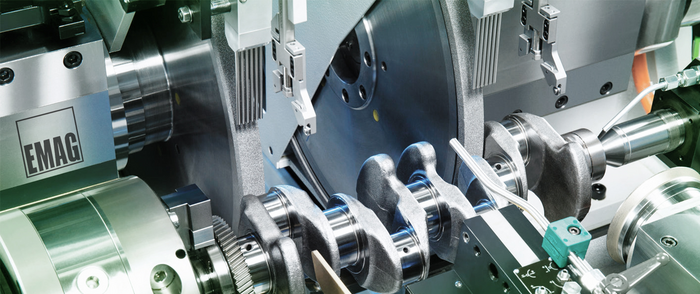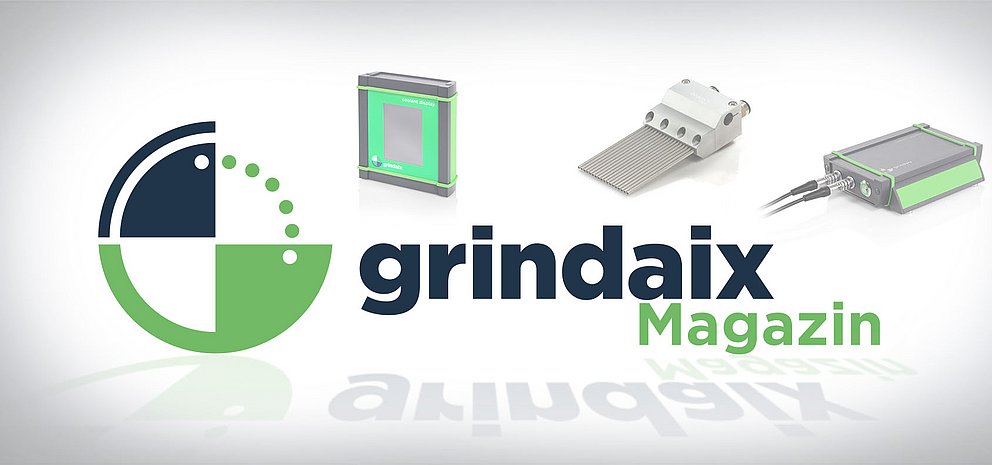Cooling during grinding
Why do parts need to be cooled during grinding?
Grinding is almost always used for the hard-fine machining of metallic parts. Due to the nature of the grinding process, a great deal of heat is generated, particularly in industrial application on CNC grinding machines. To machine parts on CNC grinding machines, a porous grinding wheel with high circumferential speed is brought into contact with the part and thereby removes chips from the part surface. Grinding is a cutting process using geometrically undefined cutting edges. Heat is generated due to the friction between the grinding wheel and the part as well as during removal of chips from the part. This heat presents a major challenge during grinding, as it can lead in the worst case to part damage (e.g. grinding burn) and thus to scrap, as the part can no longer fulfil its load requirements.
Cooling parts with coolant lubricant
Excessive heat input into the part leads to grinding burn. This is thermal damage to the rim zone of the part due to tempering and rehardening zones and/or microcracks. Grinding burn alters the part properties, so that it may be rendered unusable for its intended application. To stabilize grinding processes and to enable suitable cutting speeds and infeeds, grinding processes on CNC grinding machines are cooled with coolant lubricant. For this, either oils or emulsions (oil + water + additives) are used. Friction is thereby reduced and the process heat is bound in the coolant lubricant. The grinding process takes place at considerably cooler temperatures and may be carried out at a higher cutting speed and with higher infeed.
Besides the primary task of cooling the grinding process, the coolant lubricant can also carry out other tasks within the machine tool, for instance cleaning the grinding wheel of machining residues, flushing out chips from the machine or extinguishing the spark jet.
To convey the coolant lubricant to precisely the site in the machine tool where it is needed, coolant lubricant nozzles are used. A combination of nozzle and supply parameters allow both the direction as well as the volume flow and exit speed of the coolant lubricant to be set. To ensure that the machining task runs smoothly, these parameters need to be precisely coordinated, taking into account the process parameters.

View in the machining area of a CNC grinding machine for grinding crankshafts.
The cooling of the process is realised with needle-nozzles by Grindaix GmbH.
Image: EMAG GmbH & Co. KG
Cooling tools with coolant lubricant
With effective cooling of the grinding wheel, the service life increases considerably, as here, too, the thermal load is significantly lower. The grinding wheel in particular is subjected to thermal load during the entire machining time. Too much heat entering into the grinding wheel damages both the grinding wheel bond as well as the abrasive grits. Dressing tools also need to be cooled, as much heat is generated when the dressing tool comes into contact with the grinding wheel. To obtain a satisfactory dressing result and to ensure that the dressing tool has a sufficient service life, adequate cooling is necessary.
Cooling coolant lubricants
Due to its high thermal capacity, the coolant lubricant removes the process heat which is generated and guides it away from the machining zone. In absorbing the process heat, the coolant lubricant itself heats up. To avoid this having a negative effect on process reliability, the coolant lubricant needs to be cooled. This takes place centrally during coolant lubricant processing using cooling facilities. coolant lubricant processing also involves filtration using special coolant lubricant filtration systems.
Summary
Grinding processes must be cooled due to process heat being generated through friction and chip removal. To achieve this, coolant lubricant (oil or emulsion) is used which is introduced into the machining zone via nozzles. There, the coolant lubricant cools the process and reduces the friction between the workpiece and tool. coolant lubricant may also perform other tasks within the machine tool (e.g. cleaning the grinding wheel, bed flushing). Due to process cooling, higher cutting speeds and infeeds are possible, and the grinding process is rendered more stable, ideally without grinding burn. After use, the coolant lubricant must be processed. This includes the filtration and cooling of the coolant lubricant.
Do you have questions regarding process cooling using coolant lubricant, or do you have problems with grinding burn during production? Grindaix GmbH is your expert coolant lubricant system service provider with longstanding experience in machine and plant optimization as well as in preventing grinding burn. Feel free to contact us – we would be happy to advise you!
